|
Baldr

Aliases: Baldur, Balder, Phol, Falr
Location: Norway, Sweden, Germany, Iceland
Temple: Baldrshagi
Estimated Date: 800s A.D. - 1200s A.D.
He is the son of Odin
Baldr is the son of Odin and brother of the gods Thor, Hodr and Váli. He is known as the god of light and purity but like the other fertility gods, he also has associations with vegetation. He is the wisest and noblist of the Aesir gods and like Adonis, he had a radiant beauty.
His mother is associated with Venus
Baldr’s mother is Frigg is a wisdom goddess linked with Venus. The children of Odin and Frigg are known as the Aesir, war god rulers of the sky, like Ba’al, Apollo, Mithras or Sol Invictus, and they war against the Vanir gods, including Freyr, whose magic, nature and fertility aspects are more like Dumuzi/Tammuz, Adonis, Attis and Dionysus. The Aesir are etymologically linked to the Indo-Iranian Asura, who war against the nature-god Devas, or Suras, and the Zoroastrian Ahura, who war against the chaotic false-god Daevas. The Vishnu Purana says that during the “churning of the ocean” to create the nectar of immortality, the daityas were called the asuras because they rejected the wine goddess Varuni. The Greek Olympians are in turn equivalent to the war/storm gods, the Ba'als or Bels, reformations of the Titans such as Chronus, who was assocaited with the nature and fertility aspects of the Canaanite father-god, El the Bull, called Enlil by the Sumerians and Elohim in the Bible.
In one version of the myth, he is accidentally killed by an arrow (or spear), like Cain and Krishna
In the Prose Edda, written in 1220 by the Icelandic historian Snorri Sturluson, Baldr and Frigg have prophetic dreams of Baldr’s death, so Frigg makes every object in every realm swear an oath to not hurt Baldr, except for the harmless mistletoe. This is somewhat similar to the story in the Sepher Toledot Yeshu anti-gospel in which Jesus cursed all the trees so that none of them would hold his hanged body, a vital step in Jewish law after a criminal is stoned to death, so his body was instead hung on a cabbage stalk in the garden of his betrayer. In some versions of the myth, Loki finds out about Baldr’s “Achilles heel” and so creates a spear or arrow out of the mistletoe and tricks Baldr’s blind brother Hodr, the god of winter, into shooting a dart/arrow/spear at Baldr and helps him guide it to kill Baldr. The theme of a blind man accidentally shooting someone at another person's guidance can also be found in a story from the Talmud, the Midrash, and the apocryphal Book of Jasher, in which the pre-food patriarch Lamech, following the direction of his son Tubal-Cain, blindly shoots his ancestor Cain and then kills Tubal-Cain in grief. It is also similar to how Krishna is accidentally shot by an arrow while under a tree. Just as Hodr and Lamech accidentally kill their kindred, the Sumerian hero Gilgamesh likewise mistakenly sends Enkidu to his doom on a foolhardy quest into the netherworld. Like Lamech, Gilgamesh also has two wives. Also, just as Enosh is the older form of the name Enoch, the name Lamech could have originally been pronounced Lamesh, which gets pretty close to Gi-lgamesh. In the Epic of Gilgamesh, Gilgamesh meets the flood hero who survived in the ark and, as shown in the entry for Yanbushad, Lamech was originally a flood hero.
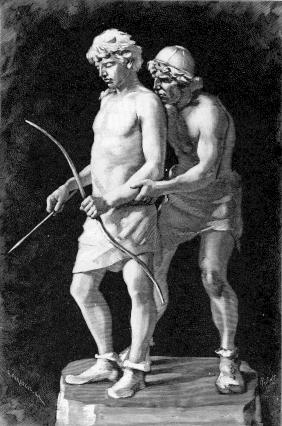
Loki tricks Holdr into accidentally shooting his brother, Baldr
In another version, he and his twin fight over a woman named Nanna, just as Dumuzi the Shepherd fights Enkimdu the Farmer over Inanna
According to the Gestsa Danorum, written by the Danish historian Saxo Grammaticus in the 1100s, and some other sources, Hodr kills Baldr on purpose. Balderus and Høtherus are rival warlords fighting for the hand of Princess Nanna of Norway. Even with the gods on his side, Balderus loses and Høtherus marries the princess. They continue to battle but because they are demi-gods, neither is mortally wounded until Høtherus kills Balderus with a magic sword named Mistletoe. The myth of Balderus and Høtherus fighting over Nanna is paralleled by the shepherd Dumuzi and the farmer Enkimdu fighting over Inanna in the Sumerian myth Inanna Prefers the Farmer. Even though older sources refer to Gilgamesh's friend Enkidu as Enkimdu, some scholars think Dumuzi's rival Enkimdu is a different person, but the Sumerian kinglists places Dumuzi the Fisherman as ruling just before Gilgamesh, implying Gilgamesh defeated and/or allied with him, which correlates with the early Sumerian myths in which Enkidu is described as the slave of Gilgamesh, corroberating my theory that the cult of Enkidu/Dumuzi the Fisherman was a reformation of the country shepherd cult to the city fisherman cult connected to Enki and the priesthood of the first city in Mesopotamia, Eridu, a fishing locale on the Persian Gulf that was part of Gilgamesh's kingdom.
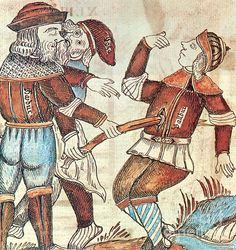
The conflict he has with his brother goes back to the story of Cain and Abel
In an Eddic poem called Baldr's Dreams, related to Snorri's Prose Edda, Odin fathers Valí for the purpose of taking revenge on Hodr and in one day Valí grows up and kills him, similar to how Apollo immediately grows up in one day to slay the dragon. The act of revenge symbolically corresponds to the conscious will of spiritual desire (vili) killing the manic or ecstatic state (odr), paralleled by the way the domesticated and cultured Apollo defeats his Dionysian rivals Tityos and Marsyas, or how the city-builder Gilgamesh cuts down Inanna's sacred tree and makes a couch representing her city Temple and tames the wild nature-boy Enkidu using the temple prostitution of Inanna's priestesses. These stories represent the struggle between the repressed charismatic folk cults of the sheep-herding countryside to the violent temple priesthoods that sustained themselves off the farming of the city. The same country vs. city conflict is represented in the Genesis story of Cain and Abel: Yahweh favors the shepherd Abel's animal sacrifice over that of Cain's farming sacrifice, causing Cain to kill his brother, after which Yahweh banishes Cain from farming so that he becomes a wanderer and then builder of the first city. In another Sumerian Myth, The Debate Between Winter and Summer, two brothers argue over whether Summer's sheep-herder animal sacrifices or Winter's farming/fishing sacrifices were more pleasing to their father, Enlil, who is equivalent to the Cannanite El the Bull and the Biblical word for God, Elohim. The esteemed Assyriologst Samuel Noah Kramer refers to it as a "Cain-and-Abel dispute", although in the Sumerian version it is naturally the farmer's sacrifice that is better since they represented the city farmer over that of the country shepherd. Although Winter does not kill Summer in the Sumerian story, it does parallel the story of Hodr, the god of winter, killing his brother Baldr. The variation in job classes is not present in the myth of Romulus and Remus, who are both shepherds and city-builders, but Romulus builds Rome after killing his twin brother Remus, just as Cain builds the city of Enoch after killing Abel. Both Romulus and Remus were conceived by the war god Mars, although a variation of this has them the sons of Hercules and a temple prostitute, often referred to in slang as lupa, or “she-wolf”, identified with the wolf-goddess Lupa and her husband, the shepherd god Lupercus (whose festival is the original Roman holy day behind Valentine's Day). Romulus and Remus are also said to have been suckled by a she-wolf after they were abandoned and set adrift on the Tiber river as infants. The Akkadian emperor Sargon the Great was likewise said to have been conceived by a Temple prostitute and set adrift on the Euphrates river until he was rescued and raised by a gardener. A Greek story written by the Greek author Aelian from around 200 A.D. says that Gilgamesh was thrown out of a tower by his father based on an Oedipal-themed oracle message that Gilgamesh would replace him, but the baby was saved by an eagle and raised by a gardener. Some Gnostics expanded the role of Judas to fit the twin myth by making him the twin of Jesus, Judas Thomas, who was later disassociated with the traitor and became a different disciple.
The conflict he has with his brother may also be related to a fight between Dumuzi and the volcano god Hephaestus
Just as Balderus and Høtherus fight over Nanna, and Dumuzi and Enkimdu fight over Inanna, the famous love triangle in Greek mythology was that of the volcano god Hephaestus (Vulcan) and the war god Ares (Mars) over the love goddess Aphrodite, the Greek equivalent of Inanna. Hephaestus caught Aphrodite and Ares in a net as they had sex and then brought them before the gods on Mt. Olympus, demanding the bride price he paid back from Aphrodite's father. The Greeks equated Ares with the Akkadian god of pestilance linked with Mars, Nergal, who the Hurrians and Hittites associated with Aplu, the god of pestilance that would become Apollo, although in Akkad and Babylon, Nergal was “king of the sunset”, possibly connecting him to Shalim, the Jebusite dusk god of Jerusalem, whose dawn god brother Shahar draws another parallel to the theme of opposing brothers. Nergal was first a war god and then later, king of the netherworld, taking Dumuzi's place as the lover/husband of Inanna's dark sister, Ereshkigal. According to a Syriac dictionary writer from the 900s A.D., Bar Bahlul, it was the shepherd Tamoza (Tammuz) who was sleeping with the wife of Hephaestus, a woman from Cyprus named Ba'alti, a name related to Belli, the title used for Tammuz's wife Ishtar. The two lovers fled to Lebanon with Hephaestus chasing after them, and although Tamoza killed Hephaestus, he was in turn slain by a boar, the same death ascribed to Adonis. An earlier Syrian Christian from the 200s A.D. is cited as giving an alternate version of the myth in which Ba'alti, queen of Cyprus, first cheated on Hephaestus with Ares and then later abandoned her throne to be with Tamoza, son of Kutar, king of Phoenicia, but while Hephaestus was hunting in Lebanon, he found them having sex and killed Tamoza. The volcanic nature of Hephaeustus also gave him the role of smith of the gods, paralleled by the name of Cain, whose name means “smith”, and just as Prometheus was said to have stolen the fire of Hephaestus and gave it to mankind, so too did Enochian tradition of the Essenes and Ethiopian Christians describe the Fall of Man as coming from Azazel and his fallen angels giving heaven-made weapons to mankind.
A jar from the Sinai portrays Yahweh as the Egyptian version of the volcano god, which could explain why Mt. Sinai sounds like a volcano
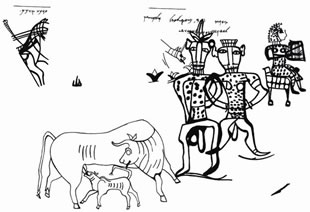
Sinai jar drawing from 700s B.C. reading “Yahweh... and his Asherah”
|
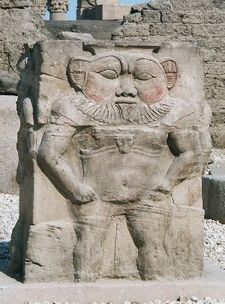
Bes, Egyptian lion-god associated with Ptah and Hephaestus
|
Hephaestus was depicted as a lame dwarf and Herodotus equated him with the Egyptian god Ptah, also described as a naked deformed dwarf. Ptah was likewise associated with the lion god Bes, whose Dionysian cult focused on sex, fertility and childbirth, as well as music and dance, and is said to have been exported from Egypt throughout the Mediterranean. A picture found on an ancient store jar excavated in 1978 from Kuntillet, a large caravan inn in the eastern Sinai desert, depicts two dwarf-like gods who look like Bes, along with a goddess strumming a lyre in the background, with an inscription reading “Yahweh... and his Asherah”. Thus, the three gods depicted are probably El, Yahweh, and Asherah, a goddess who, like Inanna, is also associated with the lioness totem and which the Bible describes as being worshipped along side Yahweh by many if not most of the women of Judah. Other inscritions refer to El, Baal, “Yahweh of Samaria and his Asherah” and “Yahweh of Teman and his Asherah.” The jar dates back to the 700s B.C. and above the picture, an inscription informing the reader that the jar belongs “to Obadaiah, Son of Adnah; may he be blessed by Yahweh”. A similar phrase was found in 1968 on a Judean tomb at Khirbet el-Qom, near Hebron. “Uri-Yahu, the Prince; this is his inscription. May ‘Uri-Yahu be blessed by Yahweh, for from his enemies he has saved him by his Asherah.” According to a mythological analysis by Sigmund Freud, Moses and Monotheism, the figure of Moses was based on two different people: an Egyptian priest of the monotheistic (henotheistic?) sun god Aten and a Midianite priest of a volcano god from Arabia, which would explain why Mt. Sinai is described in the Bible as a quaking, glowing mountain with a pillar of smoke above it that the Israelites followed to find it. Although Hephaestus is only known to be associated with volcanos in southern Italy, Yahweh may have originally been associated with an ancient volcano myth from either Italy or Arabia and then relocated to the nonvolcanic Sinai. According to Homer, Hephaestus was twice thrown off Mt. Olympus, once by Hera because of his looks and once by Zeus for trying to rescue his mother from the seduction of Zeus. Both stories are likely different versions of the same myth, perhaps describing the exclusion of older totem lion-dwarves from the an anthroporphized pantheon and/or symbolic of Venus' falling evening star, Shalim, which Jerusalem is named after and the binary pair of the rising morning star, Shahar, father of Hel-El (Lucifer). Unlike Prometheus, Hephaestus' exile from Olympus eventually ended and he was eventually brought back to Olympus drunk on a mule led by Dionysus. The Bible constantly uses the jealous husband motif to describe Yahweh's anger at the Israelites “whoring” after idols like Tammuz and Asherah, which could possibly be related to the jealousy of Hephaestus and how he was once married to Venus but then abandoned her due to her adultery with Tamoza, perhaps symbolic for the hostility of male-dominated city priesthoods to the more female-focused charismatic worship and the fertility rites and sacred prostitution associated with it.
The gods attempt to resurrect him by having everyone sympathize with his death
Another of Odin’s sons, Hermodr, rode to the netherworld and convince the Queen of the neitherworld, Hel, to release Baldr, just as Aphrodite went down to get her lover Adonis from Persephone and how Orpheus went down to get his wife Eurydice. Hel agreed to let Baldr return if every creature in the world wept of him, just as the Akkadian goddess Belili (Geshtinanna) tries to raise her brother Tammuz by getting all the women to weep for him. The gods get everyone to weep for Baldr except for a female giant named Pokk, which turns out to be Loki in disguise, and so Baldr does not return.
His death is linked to the end of the world, just like Jesus
Baldr’s death was also seen as an omen of Ragnarok, the Norse apocalypse, and Baldr is supposed to return, leading his brother Hodr, to create a new world, just as the New Testament describes the death of Jesus as heralding the apocalypse. Baldr is said to have shining white hair, just like the Son of Man in Revelation 1:13.
Baldr has the “greatest of all ships”, which may be equivalent to the ark
After he died, the gods held a funeral pyre for him and his wife, who died of grief, on Baldr's dragon ship, Hring-horni, meaning “[ship with a] ring [on the] horn”, is so large that even Thor could not push it off and needed the help of a passing giantess, who pushses it so hard it causes an earthquake. The relationship with Noah's ark is further explored in the entry for Yanbushad.
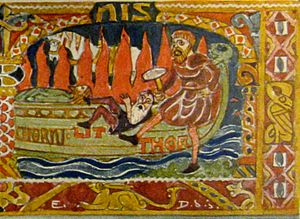
A dwarf named Litr gets underfoot while Thor consecreates
Baldr's funeral pyre and gets kicked in with him
Next Figure: Yanbushad
The Dying-and-Rising Gods
Leave Comments Here
|





